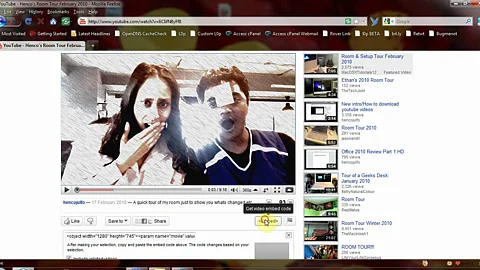
- HOMEGROWN WORLD
- #HGCREATORS
- #HGEXPLORE
- #HGVOICES
- #HGSHOP
- CAREERS
- ABOUT US
- CONTACT US

Somewhere on the internet, under the name of a long-forgotten Gmail account, is a YouTube channel that no one knows exists. The videos are short, blurry, and deeply embarrassing. In one of them, I speak directly into the camera on my iPad 2, offering a breathless list of “fun facts about me” that no one asked for. The lighting is harsh. The camera is angled upwards from a pile of textbooks. There’s no editing. No thumbnail. No subscribers. I didn’t make it for anyone else. But I uploaded it anyway.
If you were a Gen Z kid growing up in the early 2010s, chances are you did the same. Everyone had a YouTube channel, not to go viral, not to “build a brand,” not even to share with friends. You weren’t a content creator. Heck, you’d never even heard that word before. You were just a kid with internet access, a camera, and the strange, intoxicating feeling that someone could be watching.
This moment — chaotic, creative, and entirely unsupervised — was the product of a convergence of technological shifts and cultural transitions. For Indian kids in particular, it was powered by the infrastructure revolution that brought affordable internet into our homes. With telecom providers like Airtel and Jio slashing the cost of data, the internet became an ambient part of everyday life. And with the parallel rise of affordable tablets, the tools to create were right in our hands.
But this era wasn’t defined by polish, it was defined by play. You’d open Photobooth on your iPad, record a skit or a dance or a book review or a Q&A with yourself, and upload it straight to YouTube. There was no editing. and no second takes. The videos were grainy, unstructured, and deeply unserious. But that was the point. YouTube was, at the time, a sort of digital sandpit. No one was 'cultivating an audience'. No one knew about monetisation. The metrics didn’t matter. For a brief window, the internet was more about play then performance.
This is, in some ways, what made YouTube fundamentally different from Instagram, which was also rising to prominence around the same time. Instagram has always carried with it a kind of aspirationalism. Even in its early days of Valencia filters and square-cropped brunch photos, it asked you to be the best version of yourself. It encouraged aesthetic coherence. YouTube, by contrast, was a loveable shitshow. It was loud, unscripted, and often spectacularly cringe. And in that chaos was freedom.
Of course, there was something deeply democratic about it, too. While kids’ voices were often minimised or patronised, YouTube gave us a kind of sovereignty. You could speak directly to the world, even if the world wasn’t really listening. You could be your own protagonist, director, and distributor. You could watch yourself, and in doing so, begin to piece together an idea of who you were becoming.
But for all its creative potential, this era of digital childhood also came with costs. Because while we may have started off uploading for fun, the nature of documenting your life — even to an invisible audience — inevitably shapes the way you live it. You begin to think of yourself in scenes. You develop a split-screen consciousness: living life while also imagining how it will look when uploaded. You stage moments because you ‘could’ be watched. That imagined gaze, the idea that someone might be seeing you, starts to harden into habit.
There’s a kind of surveillance in this, even when it comes from ourselves. As the platforms matured, so did the stakes. The internet, once a playground, became a marketplace. Metrics began to matter. Virality became a career path. Suddenly, those same grainy videos that once felt liberating began to feel like liabilities: embarrassing, cringe, and horriftingly traceable. We started to hide them, scrub them, and archive them. The digital freedom we once took for granted gave way to a kind of image management that followed us into adolescence.
This tension still defines the way Gen Z relates to the internet. We were the first generation to truly grow up online, and we did so before the consequences were fully understood; before the permanent nature of the internet became common wisdom; before digital footprints became part of college applications and employment screenings; before we even had the vocabulary for digital identity, parasocial relationships, or algorithmic bias. We didn’t know that a channel created at age 11 could resurface at age 21 or that a joke in one context could be weaponised in another or that growing up in public meant never quite escaping your past selves.
I can’t bring myself to delete that old YouTube channel. (I have no idea what the password is either.) I would be mortified if anyone ever saw it, but it’s also a record of a time when the internet was about creative self-recognition. It was about making something, anything, just because you could. There’s something tender about that version of the internet. It was full of possibility: of kids learning to speak, to share, and to see themselves.
It’s easy now to mourn what the internet has become: capitalised, commodified, and surveilled. Performance is indistinguishable from personality. But once upon a time, we weren’t posting to be seen. We were posting because it was fun. That’s what I keep going back to: not the videos themselves, but the version of me that made them; a person who didn’t care if no one was watching and who made things not to be perfect, but simply to be. That’s worth holding onto.
If you enjoyed reading this, here's more from Homegrown:
Indian Tennis Prodigy Maaya Rajeshwaran Revathi Is Heading To Rafa Nadal's Academy
Waves Of Change: How SeaSisters Is Empowering Women On Sri Lanka's Southern Coast
Revisit Some Of Our Most Powerful Women-Centered Stories From The Year That's Passed
